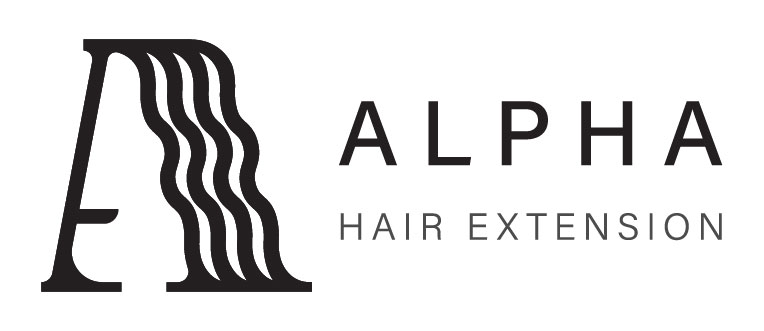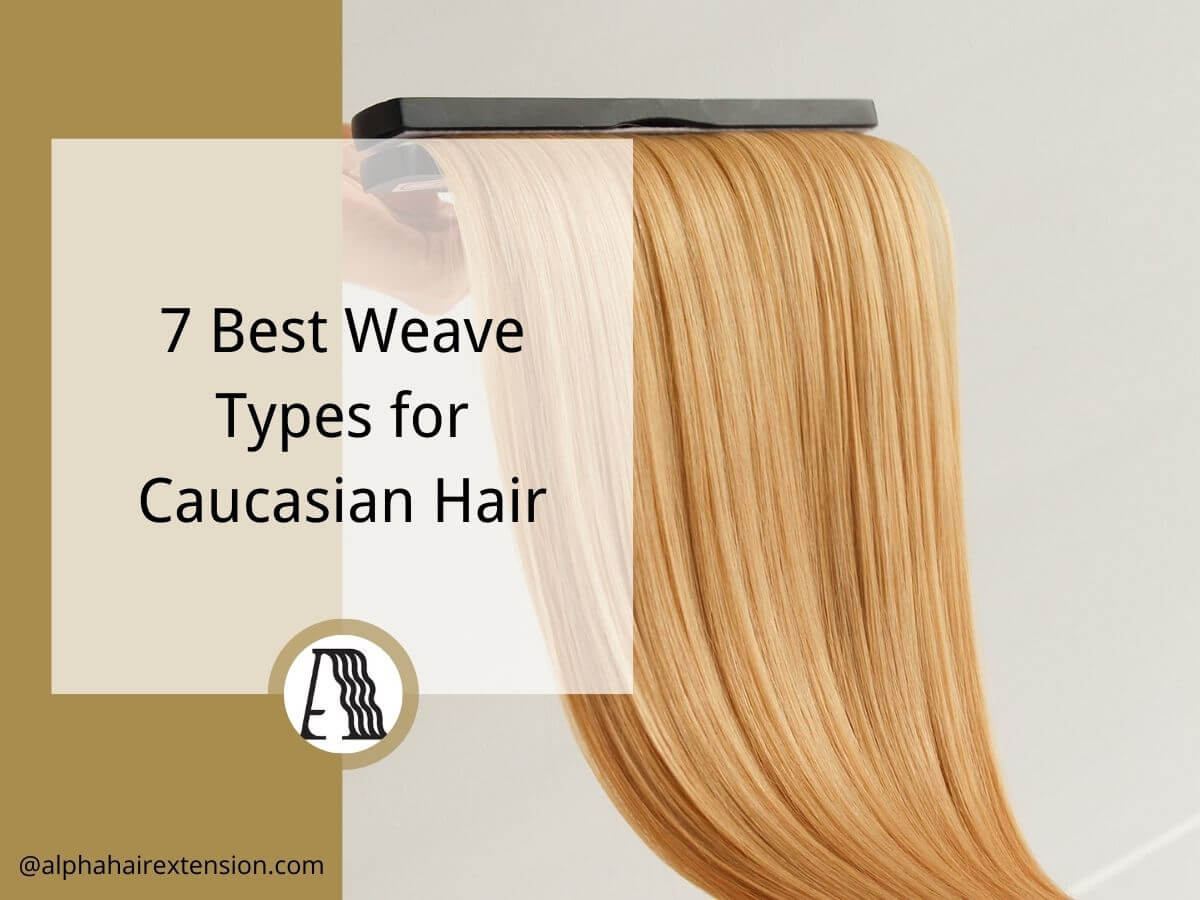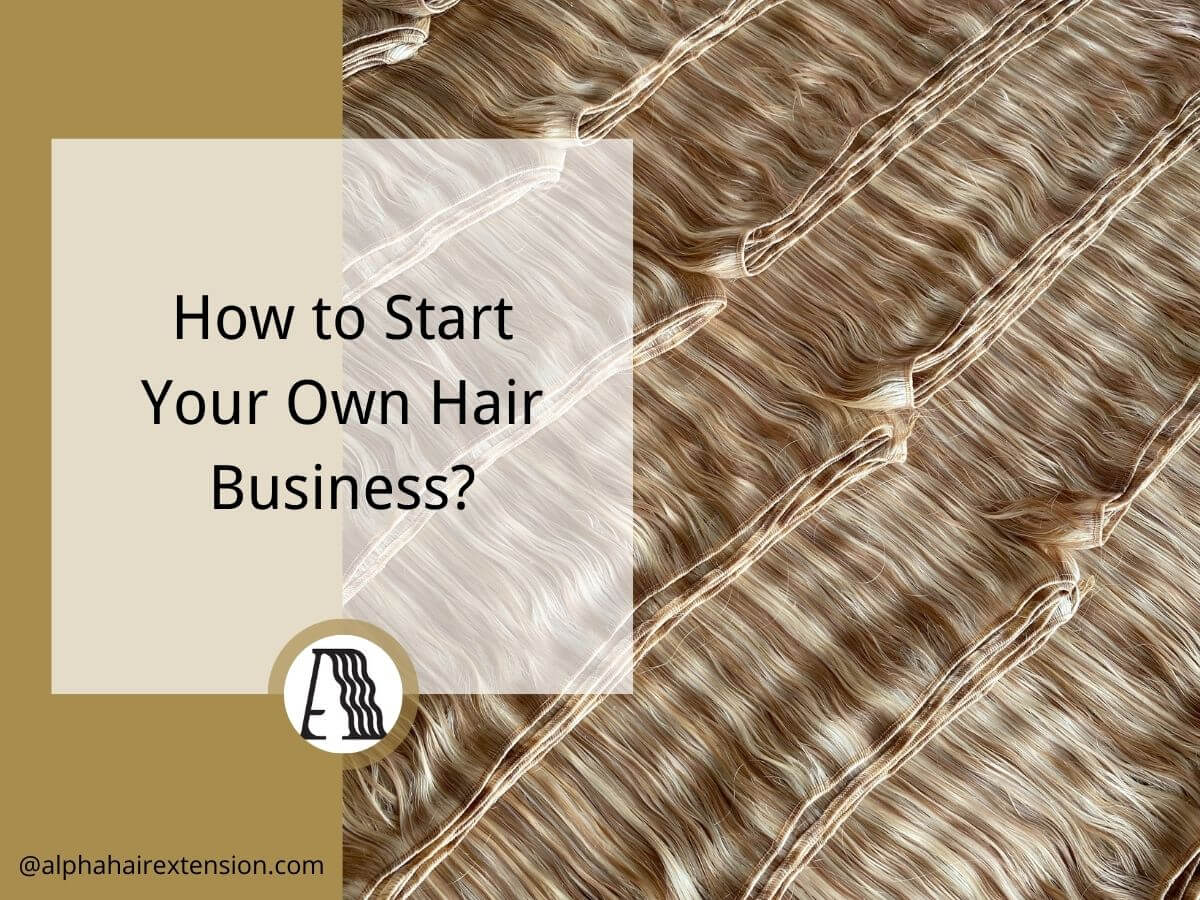Most hair businesses fail for one simple reason: they sell bad hair. And it’s usually not their fault. Suppliers lie. Labels are misleading. And “100% human hair” doesn’t always mean what you think.
I know this because I’ve been in the industry for years. I’ve tested suppliers, hair types, and sourcing methods. Some claim to sell real hair but once heat is applied, it melts, tangles, or smells like plastic.
If you’re running a hair business, you need to know how to verify your hair before you sell it and that’s what this guide is for.
Inside, I’ll walk you through easy tests to check for real human hair, before you waste money on a bad batch. By the end, you’ll be able to spot fake hair instantly, avoid scams, and keep your reputation intact.
So, let’s get started!
1. Check the Hair Cuticles (Most Reliable Method)
Have you ever bought hair extensions that felt soft at first, only to turn into a tangled mess after a few washes? This happens because many suppliers strip or coat the hair cuticles to make it look smooth until the coating wears off.
If you want real, high-quality human hair, checking the cuticles is the best way to tell if it’s authentic.
Cuticles are the outermost layer of the hair shaft. They act like tiny overlapping scales that protect the hair. Real human hair has intact cuticles. They keep the strands smooth, strong, and resistant to tangling.
But here’s the problem many suppliers chemically process the hair to remove the cuticles. This makes the hair weaker, more prone to breakage, and less durable over time.
That’s why a cuticle test is essential before buying.
How to Do a Cuticle Test
This test takes less than 10 seconds, and you don’t need any tools.
- Take a strand of hair (from a bundle or extension).
- Hold it between your fingers.
- Gently slide your fingers from tip to root.
- Now, reverse the motion slide from root to tip.
If it feels smooth in one direction and rough in the other, the cuticle is intact. That means the hair is real, unprocessed human hair.
If it feels smooth in both directions, the cuticle has been removed. This means the hair is likely chemically processed or synthetic.
Why Cuticles Matter
- Tangle Prevention – Hair with cuticles aligned in one direction (Remy hair) tangles less and lasts longer.
- Stronger Strands – Cuticle-intact hair resists breakage and damage.
- Better Styling – It holds curls and color better than processed hair.
If you’re running a salon, e-commerce store, or brand, selling hair with intact cuticles means fewer customer complaints and more repeat buyers.
So before buying, always do a cuticle test. It’s a simple step that can save you thousands in refunds and lost sales.
2. Perform the Burn Test (Quickest DIY Method)
One of the fastest and most effective ways to check is the burn test. It takes just a few seconds and gives you a clear answer.
Why does the burn test work?
Real human hair and synthetic fibers burn in completely different ways. Human hair contains keratin, a natural protein that burns slowly and turns to ash.
Synthetic hair, on the other hand, is often made from plastic or nylon fibers. When exposed to fire, it melts, smells like plastic, and forms a hard ball instead of turning to ash.
How to Do a Burn Test
This test is a quick way to separate real hair from fakes before making a big purchase. You’ll need:
✔ A few strands of hair (cut from the bundle)
✔ A lighter or match
✔ A safe, non-flammable surface
Once you’re ready, follow these steps to test the hair safely and accurately:
- Take a few strands of hair and hold them with tweezers.
- Light the strands carefully and watch how they burn.
- Observe the smell, texture, and ashes.
Now that you’ve performed the test, pay close attention to what happens next.
The way the hair burns, smells, and reacts will tell you whether it’s real human hair or a synthetic mix. Here’s what to look for in the results:
✅ Real Human Hair:
- Burns slowly
- Smells like burnt protein (similar to feathers or fingernails burning)
- Turns into soft gray ash that crumbles easily
❌ Synthetic or Mixed Hair:
- Melts quickly
- Smells like burning plastic
- Forms a hard ball instead of ash
Things to Keep in Mind
- Use this test on small samples, not full bundles. Burning a full weft could damage the hair unnecessarily.
- If the hair melts instead of burning, it’s fake. Some suppliers mix synthetic strands with human hair, so one or two burning strands may not tell the whole story. Always test multiple sections.
- This method is best for verifying raw hair before purchase. If the hair is heavily processed or coated in silicone, the test may not be as reliable.
If you’re in the hair business, selling real human hair is key to keeping customers happy. The burn test is a quick and easy way to check before making a bulk purchase.
But it’s just one step, always combine it with other tests to make sure you’re getting what you pay for.
3. Do the Bleach Test (For Hair Quality Assessment)
So far, you’ve tested for synthetic fibers using the burn test. But what if the hair is real, yet still low quality?
Bleaching is one of the best ways to check hair quality. Real human hair reacts to bleach by lightening, while synthetic or heavily processed hair stays the same or melts. This test is especially helpful if you want to sell, dye, or customize hair extensions.
But before you start, let’s go over exactly how to do it.
How to Do a Bleach Test
You’ll need:
✔ A few strands of hair (cut from the bundle)
✔ Bleach powder
✔ Developer (30 or 40 volume)
✔ Gloves and a mixing bowl
Now that you have everything ready, here’s how to perform the test:
- Mix the bleach and developer according to the instructions.
- Apply a small amount to the hair strands.
- Let it sit for 10–15 minutes.
- Observe how the hair reacts.
Now, let’s break down what your results mean.
✅ Real Human Hair:
- Lightens within 10–15 minutes.
- May turn orange, blonde, or lighter brown, depending on the original color.
- The strand remains intact.
❌ Synthetic or Mixed Hair:
- Does not lighten or change very little.
- May melt, become sticky, or break apart.
- Gives off a chemical smell when exposed to bleach.
Why the Bleach Test Matters
If the hair passes the cuticle test and burn test, it may seem like a safe purchase. But the bleach test goes a step further, it helps you judge the quality of the hair, not just its authenticity.
Here’s why it’s important:
- Virgin Hair vs. Processed Hair – Virgin hair (untreated) lifts faster. If bleaching takes too long, the hair may be chemically processed or coated.
- Determining Hair Strength – If the hair becomes weak, gummy, or stretchy after bleaching, it’s likely low-quality or mixed with non-human fibers.
Even if the hair is real, excessive chemical processing reduces its lifespan and limits its styling options.
Knowing how hair reacts to bleach can help you avoid low-quality or overly processed products.
Next, let’s move on to another key test.
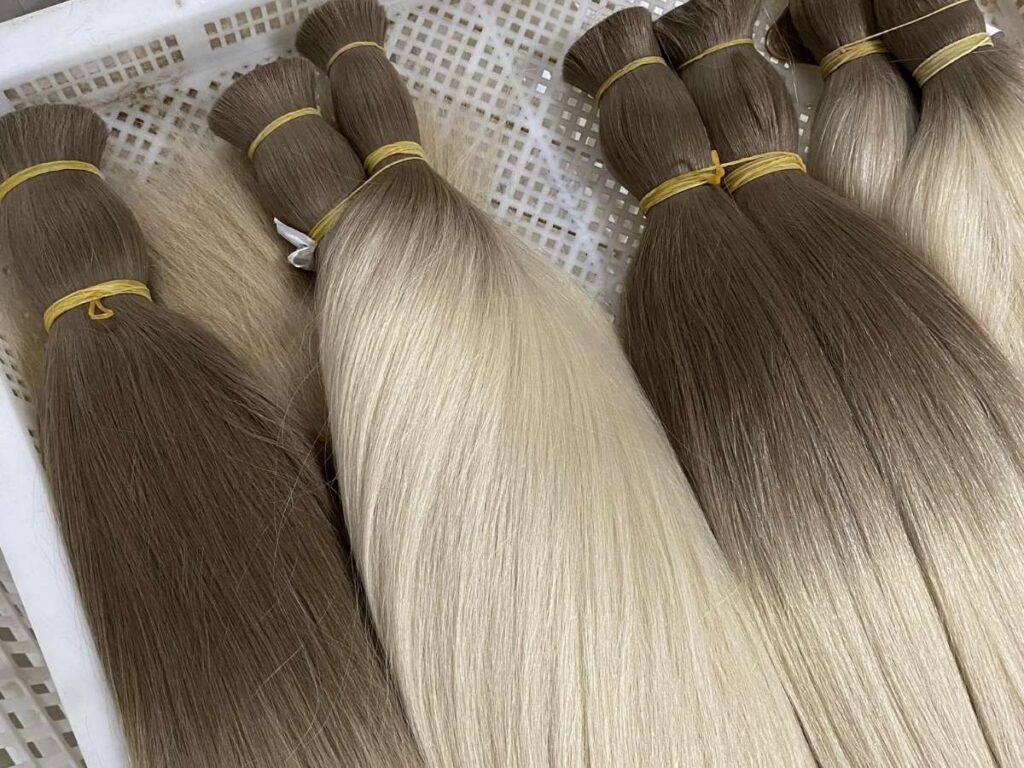
4. Observe Hair Texture & Behavior When Wet
Real human hair reacts naturally to water, absorbing it and becoming heavier. Synthetic or mixed fibers, on the other hand, repel water or feel unnatural when wet.
If you want to avoid low-quality or blended hair, this test is simple and effective.
How to Check Hair Behavior When Wet
You don’t need any special tools, just water and a few strands of hair.
- Take a small section of hair from the bundle.
- Submerge it in water or spray it until fully wet.
- Observe how the hair reacts during and after contact with water.
Now, let’s break down what to look for.
✅ Real Human Hair:
- Absorbs water gradually instead of repelling it.
- Becomes heavier when wet (because it holds moisture).
- Remains soft and flexible, even after drying.
❌ Synthetic or Blended Hair:
- Repels water or takes longer to absorb.
- Feels sticky, stiff, or plasticky when wet.
- Hardens or clumps together when dry.
Why This Test Matters
If you sell or install hair extensions, your customers expect natural movement and durability. Fake or mixed hair often loses its softness, making it harder to style, wash, or maintain.
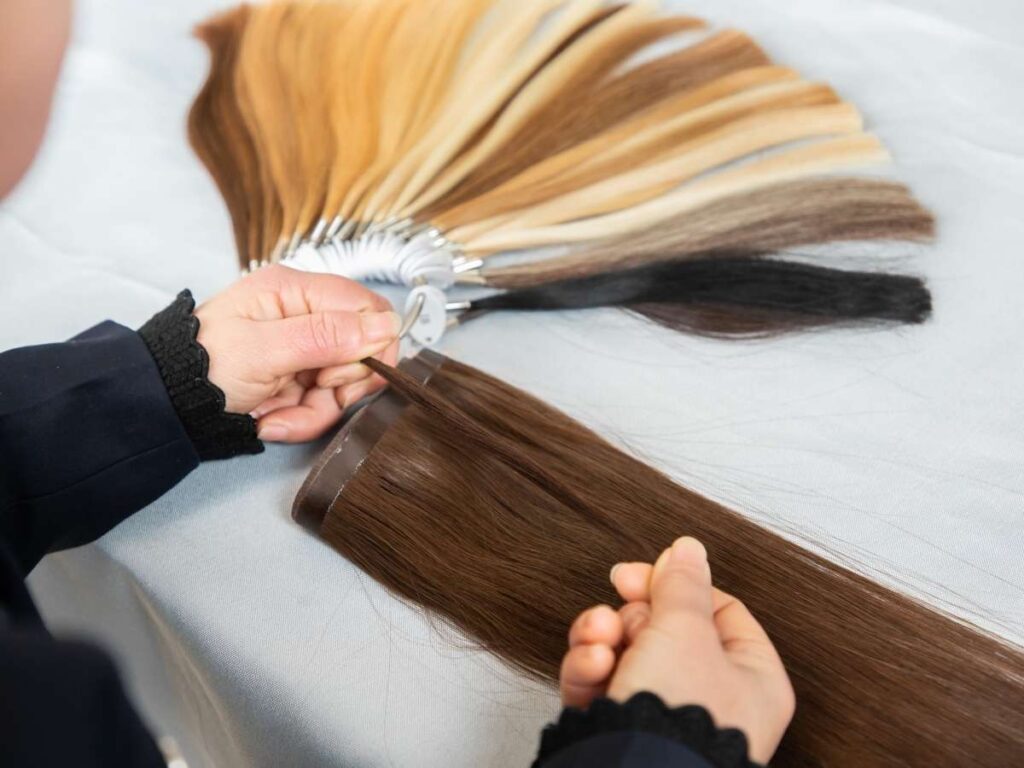
5. Smell the Hair (Detect Chemical Processing)
Hair should smell natural. But if it reeks of chemicals or plastic, there’s a problem. Many low-quality hair suppliers use acid baths, silicone coatings, or synthetic blends to make the hair look smoother and shinier. These treatments leave behind a strong, unnatural odor, especially when wet or heated.
A quick smell test can help you detect over-processed, low-quality hair before you buy.
How to Check Hair by Smell
- Take a small section of hair from the bundle.
- Wash it with plain water (no shampoo or conditioner).
- Let it sit for a few minutes, then smell it.
- For an extra test, apply heat with a blow dryer or flat iron.
Now, here’s what to expect based on your results:
✅ Real Human Hair:
- Has a natural, earthy, or slightly musty scent (due to storage or donor origin).
- May have a mild shampoo smell if pre-washed by the supplier.
- When heated, smells like burning protein (similar to burnt feathers).
❌ Synthetic or Mixed Hair:
- Smells like chemicals, acid, or plastic (especially when wet).
- Gives off a strong, artificial scent after washing.
- Produces a plastic-burning smell when exposed to heat.
Why This Test Matters
Hair that smells too strong or artificial is often heavily processed, chemically treated, or mixed with synthetic fibers. While some suppliers wash their hair lightly before selling, no amount of shampoo can fully remove the chemical scent from over-processed hair.
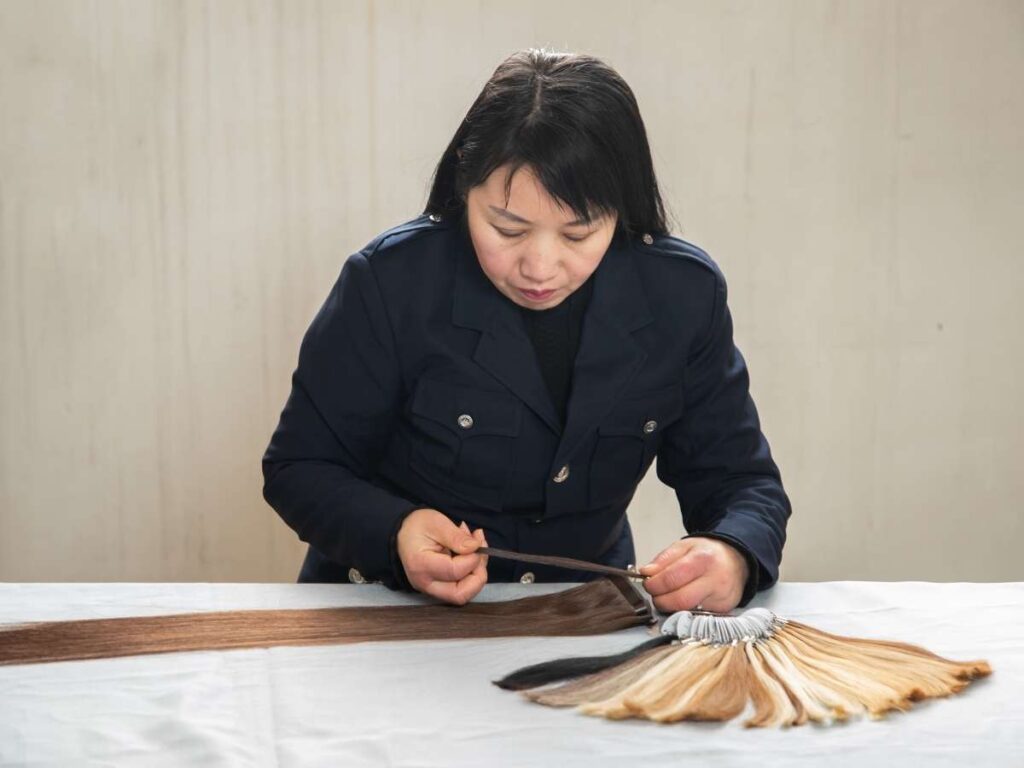
6. Check the Hair’s Heat Resistance (Flat Iron Test)
If you or your customers plan to curl, straighten, or style extensions with heat, this test is essential. Real human hair can handle high temperatures, while synthetic or mixed fibers will melt, stiffen, or smell like burning plastic.
This quick test can save you from selling or installing hair that won’t last or restyle properly.
How to Do a Heat Test
Before starting, make sure you have:
- A flat iron or curling iron (set to 180–200°C / 350–390°F)
- A few strands of hair from the bundle
- A heat-resistant surface to place the hair on
Once you’re ready, follow these steps:
- Take a small section of hair.
- Clamp the flat iron on the hair and slide it down.
- Observe how the hair reacts to heat.
- After styling, wash the hair and check if it returns to its original texture.
Once you’ve done this, it’s time to check your results:
✅ Real Human Hair:
- Styles naturally without melting.
- Holds curls or straightens smoothly.
- Returns to its natural state after washing.
❌ Synthetic or Mixed Hair:
- Melts, stiffens, or becomes sticky.
- Produces a strong chemical or plastic-burning smell.
- Does not bounce back to its original texture.
This test is especially useful for clip-in and tape-in extensions, which are often blended with synthetic fibers.
Why This Test Matters
By now, you may have identified fake or low-quality hair using earlier tests. But even if the hair seems real, it still might not be high quality.
Your customers expect extensions to last, hold styles, and be reusable. If the hair melts or loses its shape after the first use, it’s a bad investment for both you and them.
A heat test is a simple but powerful way to check if the hair is truly worth selling or installing.
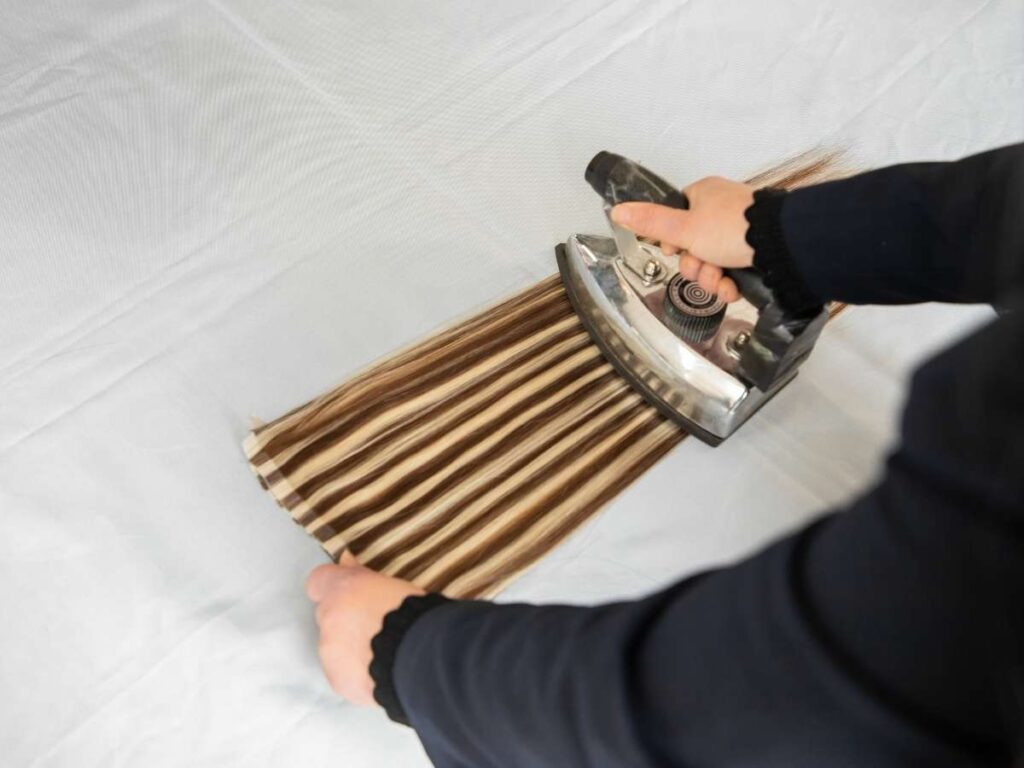
7. Request a Sample Before Bulk Purchasing
By now, you’ve learned multiple ways to test hair for authenticity and quality. But before making a large investment, there’s one final step that can save you from costly mistakes. Ordering a sample.
No matter how convincing a supplier’s claims are, never commit to bulk orders without testing a sample first. Many sellers use edited product photos or misleading descriptions, making it impossible to judge the hair’s true quality just from pictures.
Requesting a sample allows you to inspect, test, and verify whether the hair meets your standards before placing a big order.
What to Ask for When Requesting a Sample
When reaching out to a manufacturer or supplier, be clear and specific about what you need. Here are some things to request:
- A small bundle or weft (typically 100 grams) for testing
- Unprocessed hair (without excessive silicone coating or chemical treatments)
- Information on sourcing (Is it virgin hair? Remy? Single donor?)
- Details about return policies in case the hair doesn’t match expectations
If the they refuses to send a sample, that’s a red flag. A reliable supplier should be confident in their product and willing to provide a sample.
At Alpha Hair, we believe in full transparency. When you request a sample, you get the exact quality you can expect in bulk orders. No surprises, no misleading marketing.
Warning Signs to Watch For
Not all samples tell the full story. Some suppliers send high-quality samples but deliver lower-quality bulk orders once you commit. Here’s what to look out for:
- The sample is drastically better than the actual order (this is a bait-and-switch tactic).
- The supplier refuses to send a sample or only offers a sample at an unreasonable price.
- The hair is coated in silicone (feels unnaturally smooth but deteriorates after washing).
- No clear return policy or guarantees for larger orders.
A small test order can prevent big losses and protect your brand from selling low-quality hair.
Once you’ve received and tested your sample, you’ll have the confidence to move forward or the proof you need to walk away.
Conclusion
You’ve learned how to spot fake hair, test for quality, and choose better suppliers. But the most important step? Actually using what you’ve learned.
Knowledge alone won’t protect your business. Action will.
What’s your next move? Will you test before you buy? Will you partner with a supplier that proves its quality upfront?
Contact us today to request a sample and make the best decision for your brand.
Explore More Helpful Resources
If you’re looking for more insights, we’ve put together a list of helpful articles that you might enjoy:
Still haven’t found what you’re looking for? Don’t hesitate to contact us. We’re available around the clock to assist you.
